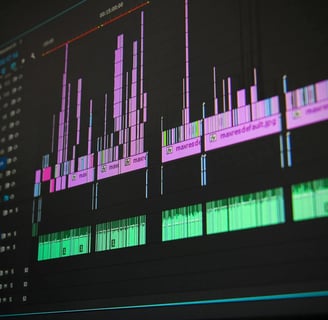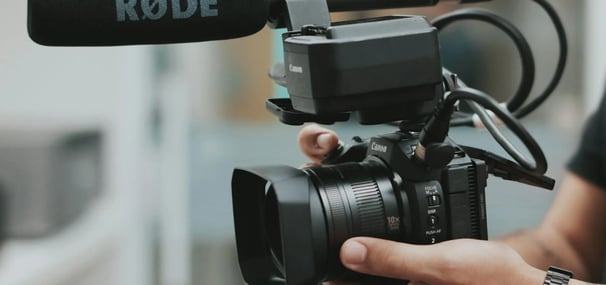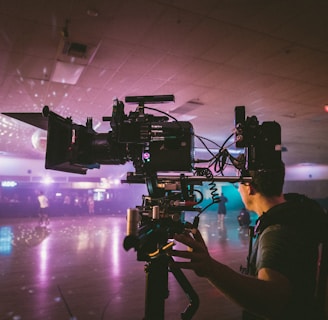
The Emotion of Motion
Videography: Bringing Stories to Life


Videography: Bringing Stories to Life
📽️ Lights, camera, action! In a world where attention spans are shorter than ever, videography has emerged as a powerful tool to capture hearts and minds. From viral social media clips to cinematic masterpieces, the art of visual storytelling has the unique ability to transport viewers into new worlds, evoke emotions, and leave lasting impressions.
But what separates an amateur video from a compelling visual narrative? How can you harness the power of videography to bring your stories to life? Whether you're a budding filmmaker, a content creator, or a business looking to elevate your brand, understanding the essentials of effective videography is crucial in today's digital landscape.
Join us as we embark on a journey through the world of videography, exploring everything from pre-production planning to post-production magic. We'll uncover the secrets behind powerful visual storytelling, dive into production techniques that create impact, and reveal how to adapt your videos for different platforms. Plus, we'll peek into the future with emerging trends that are reshaping the industry. 🚀 Get ready to transform your ideas into unforgettable visual experiences!
The Power of Visual Storytelling
Connecting with audiences through compelling visuals
In the realm of videography, the power of visual storytelling lies in its ability to forge deep connections with audiences. Compelling visuals have the unique capacity to transcend language barriers and cultural differences, speaking directly to the viewer's emotions and experiences.
To create impactful visuals, consider the following elements:
Composition
Lighting
Color palette
Camera movement
Pacing
Element Purpose Impact Composition Frames the subject Directs viewer's attention Lighting Sets mood and atmosphere Enhances emotional response Color palette Establishes visual tone Reinforces brand identity Camera movement Guides viewer's perspective Creates dynamic engagement Pacing Controls narrative flow Maintains viewer interest
Evoking emotions and creating lasting impressions
The true artistry of videography lies in its ability to evoke powerful emotions and leave lasting impressions on viewers. By carefully crafting each shot and scene, videographers can:
Trigger empathy and connection
Inspire action or change
Create memorable experiences
Enhancing brand identity and message delivery
Visual storytelling is a potent tool for reinforcing brand identity and effectively delivering messages. Through consistent visual elements, tone, and style, videos can:
Strengthen brand recognition
Communicate complex ideas simply
Increase audience engagement and retention
By harnessing the power of visual storytelling, videographers can create content that not only captivates but also resonates deeply with viewers, making it an invaluable medium for communication in today's visually-driven world.
Essential Elements of Effective Videography
Crafting a compelling narrative
A compelling narrative is the backbone of any successful video. It's not just about what you show, but how you tell the story. To craft a narrative that resonates:
Identify your core message
Develop relatable characters or themes
Create a clear story arc
Use visual elements to support your narrative
Remember, even short-form videos need a narrative structure to engage viewers effectively.
Mastering composition and framing
Composition and framing are crucial for creating visually appealing and impactful videos. Key principles include:
Rule of thirds
Leading lines
Symmetry and balance
Depth of field
Technique Purpose Example Wide shot Establish context Opening scene of a landscape Medium shot Show relationships Two people conversing Close-up Convey emotion Character's facial expression
Utilizing lighting to set the mood
Lighting plays a pivotal role in videography, influencing the atmosphere and emotional impact of your footage. Consider:
Natural vs. artificial light
Hard vs. soft light
Color temperature
Three-point lighting setup
Experiment with different lighting techniques to create the desired mood for your video.
Capturing high-quality audio
Often overlooked, audio is equally important as visuals in videography. To ensure crisp, clear sound:
Use external microphones
Monitor audio levels during the recording
Minimize background noise
Consider room acoustics
High-quality audio enhances the overall viewing experience and helps maintain audience engagement throughout your video.
Pre-Production: Laying the Foundation
Developing a clear concept and storyboard
Before diving into filming, it's crucial to develop a clear concept and create a detailed storyboard. This process involves brainstorming ideas, defining the message, and visualizing the narrative flow. A well-crafted storyboard serves as a visual roadmap for your video project, ensuring all team members are aligned with the creative vision.
Key elements of an effective storyboard:
Shot-by-shot breakdown
Camera angles and movements
Dialogue or voiceover notes
Visual effects or transitions
Storyboard Component Purpose Sketches Visualize each scene Shot descriptions Define camera work Dialogue/Action Outline script elements Timing Estimate scene duration
Scouting locations and planning shots
Once the storyboard is complete, the next step is to scout locations and plan your shots. This phase is critical for identifying potential challenges and opportunities in your chosen filming environments.
Research and visit potential locations
Assess lighting conditions at different times of day
Consider acoustics and potential sound issues
Plan for logistical needs (power sources, permits, etc.)
Assembling the right team and equipment
The success of your video project heavily depends on having the right team and equipment. Carefully select crew members based on their expertise and the specific needs of your project.
Essential team members may include:
Director
Cinematographer
Sound engineer
Lighting technician
Equip your team with the necessary tools, such as cameras, lenses, lighting gear, and audio equipment. Remember, the quality of your equipment can significantly impact the final product, so invest wisely in gear that aligns with your project's requirements and budget.
Production Techniques for Impactful Videos
Choosing the right camera angles and movements
Selecting the appropriate camera angles and movements is crucial for creating visually engaging videos. Wide shots establish the scene, while close-ups capture emotions and details. To add depth, consider using the rule of thirds and leading lines. Dynamic camera movements like pans, tilts, and dolly shots can enhance storytelling and maintain viewer interest.
Camera Angle Purpose Best Used For Wide Shot Establishes context Scene introductions Medium Shot Shows relationships Conversations Close-Up Highlights emotions Emotional moments Dutch Angle Creates tension Dramatic scenes
Incorporating dynamic transitions
Seamless transitions between scenes maintain flow and keep viewers engaged. Some effective techniques include:
Match cuts
J and L cuts for audio transitions
Whip pans
Dissolves for time passage
Directing talent for authentic performances
Guiding on-camera talent is essential for creating authentic and compelling content. Key strategies include:
Conduct thorough pre-shoot discussions
Encourage natural movements and expressions
Provide clear, concise direction
Allow for multiple takes to capture the best performance
Balancing technical expertise with creative vision
While technical skills are crucial, it's equally important to maintain a creative perspective. Strive for a balance between:
Proper exposure and lighting
Composition and framing
Audio quality
Storytelling elements
By mastering these production techniques, videographers can create impactful videos that resonate with audiences and effectively convey their intended message. Next, we'll explore how post-production can further enhance your video content.
Post-Production Magic
A. Editing for maximum impact and engagement
Editing is where the raw footage transforms into a cohesive story. To maximize impact and engagement, focus on pacing, continuity, and emotional resonance. Use a variety of cuts to maintain viewer interest:
J-cuts and L-cuts for smooth transitions
Match cuts for visual continuity
Montages to compress time and convey progression
Cut Type Purpose Example J-cut Audio leads video Hearing dialogue before seeing the speaker L-cut Video leads audio Seeing a reaction before hearing the cause Match cut Visual continuity Cutting from a spinning wheel to a rotating fan
B. Color grading to enhance visual appeal
Color grading is crucial for setting mood and creating a consistent look. Start with color correction to balance exposure and white balance, then move to creative grading:
Choose a color palette that complements your story
Use LUTs (Look-Up Tables) for efficient grading
Adjust saturation, contrast, and hue to achieve desired atmosphere
C. Adding music and sound effects
Sound design elevates your video's emotional impact. Consider these elements:
Background music to set the tone
Ambient sounds for realism
Sound effects to emphasize actions
Foley for added texture
D. Creating compelling graphics and titles
Graphics and titles provide context and reinforce your message. Keep them:
Consistent with your visual style
Legible and appropriately sized
Animated smoothly for visual interest
Incorporate lower thirds, animated logos, and infographics to enhance information delivery without overwhelming the visuals.
Adapting Videography for Different Platforms
Optimizing for social media consumption
In the fast-paced world of social media, capturing viewers' attention is crucial. Here are key strategies for optimizing your videography for social media platforms:
Create attention-grabbing openings
Use subtitles or captions for silent viewing
Keep videos concise (15-60 seconds)
Incorporate trending music or sounds
Use the vertical format for mobile-friendly viewing
Platform Ideal Video Length Recommended Format Instagram 15-30 seconds Square or Vertical TikTok 15-60 seconds Vertical Facebook 1-3 minutes Landscape or Square Twitter 30-45 seconds Landscape
Crafting longer-form content for websites and presentations
Longer-form video content allows for more in-depth storytelling and detailed information sharing. Consider these tips:
Create a compelling narrative structure
Use chapters or segments for easy navigation
Incorporate high-quality b-roll footage
Include expert interviews or testimonials
Optimize for SEO with relevant titles and descriptions
Tailoring aspect ratios and formats for various devices
To ensure your videos look great across all devices, consider the following:
16:9 for landscape viewing (desktop, TVs)
9:16 for vertical viewing (mobile devices)
1:1 for square format (social media feeds)
4:3 for older devices or presentation slides
Remember to shoot with the widest aspect ratio possible, allowing for cropping to different formats in post-production. This flexibility ensures your content remains adaptable across various platforms and devices, maximizing its reach and impact.
Emerging Trends in Videography
Embracing virtual and augmented reality
Virtual and augmented reality (VR/AR) are revolutionizing videography, offering immersive experiences that transport viewers into new worlds. VR allows for complete 360-degree environments, while AR enhances real-world footage with digital overlays. These technologies are opening up exciting possibilities for storytelling and audience engagement.
Technology Key Features Applications Virtual Reality Fully immersive, 360-degree environments Gaming, virtual tours, training simulations Augmented Reality Digital overlays on real-world footage Educational content, interactive marketing, live events
Incorporating aerial footage with drones
Drone videography has soared in popularity, providing stunning aerial perspectives that were once cost-prohibitive. This technology allows videographers to:
Capture sweeping landscape shots
Follow moving subjects from unique angles
Access hard-to-reach locations safely
Exploring 360-degree video experiences
360-degree videos offer viewers control over their perspective, creating an interactive and engaging experience. This format is particularly effective for:
Virtual tours of real estate or tourist destinations
Immersive documentaries and news reporting
Interactive music videos and live concert recordings
Leveraging AI and machine learning in video production
Artificial intelligence and machine learning are transforming various aspects of video production:
Automated editing and color correction
Smart object tracking for smoother shots
Enhanced visual effects and CGI integration
Personalized video content based on viewer preferences
These emerging trends are reshaping the videography landscape, offering new tools and techniques for creators to bring their stories to life in increasingly innovative and engaging ways.
Conclusion
Videography is a powerful medium that brings stories to life through the art of visual storytelling. From pre-production planning to post-production magic, every step in the videography process plays a crucial role in creating impactful and engaging content. By mastering essential elements such as composition, lighting, and sound, videographers can craft compelling narratives that resonate with their audience across various platforms.
As technology continues to evolve, so does the field of videography. Staying informed about emerging trends and adapting to new techniques will be key for videographers looking to push the boundaries of their craft. Whether you're a seasoned professional or just starting out, remember that the heart of videography lies in its ability to connect with viewers on an emotional level. So, pick up your camera, unleash your creativity, and start bringing your stories to life through the lens.











